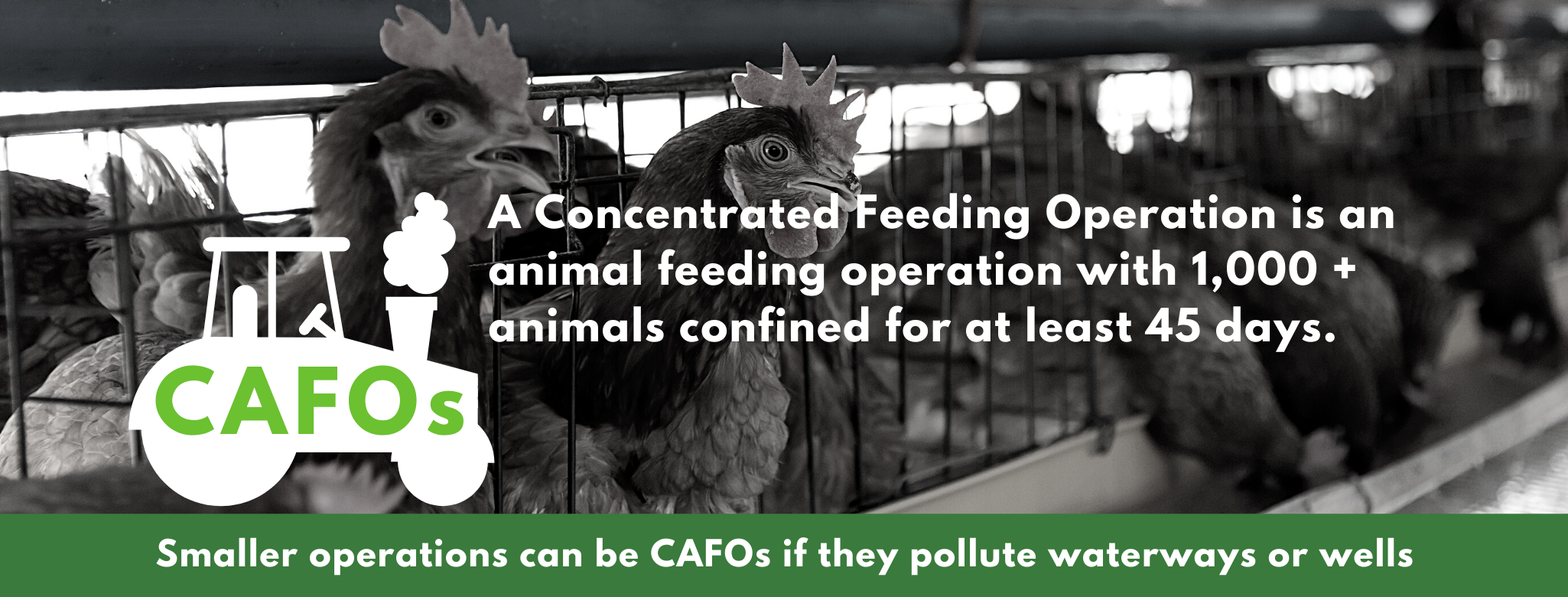A concentrated animal feeding operation (CAFO) is a confined agricultural facility in which feed is brought to the animals, instead of providing fields or rangeland. CAFOs range in size and can hold anywhere from hundreds to millions of animals, typically cows, hogs, chickens. The massive amount of manure produced by these animals is the basis for many of the health impacts associated with CAFOs. Manure is full of various pathogens, such as E. coli, antibiotics, chemicals from farm equipment, and trace metals.(1) A single CAFO can produce more waste than some U.S. cities. For instance, a facility with 800,000 pigs can produce over 1.6 million tons of waste a year, or 1.5 times more than the sanitary waste produced by the city of Philadelphia each year.(2) A dairy farm of 500 cows produces as much waste as South Milwaukee.(3)
Massive amounts of waste created from CAFOs are not treated in sewage systems and are instead contained in lagoons or pits, leading to large greenhouse gas emissions, groundwater pollution, surface water contamination, and air pollution. Manure management is the fourth leading source of nitrous oxide emissions in the U.S. and nitrous oxide is 300 times more potent for warming than carbon dioxide.(4) Manure management also the fifth leading source of methane which is 23 times more potent.(4)
Manure in pits is difficult to contain and can run-off in storms, leak, or leach into the soil. Manure contains ammonia, nitrates, hormones, viruses, trace metals and over 150 pathogens that can impact human health.(1) A single pollution event by a CAFO can become a longer-term health threat because viral contamination can attach to sediment near groundwater and continue to slowly leach out into groundwater.(5) A 2007 study of CAFO sites found that over 80% of surface water tested contained Giardia and Cryptosporidium parvum, both of which affect human health.(6) There is also strong evidence that antibiotics found in animal feed, and later waste-water run-off, also lead to an increase in antibiotic-resistant microbes.(7) This makes humans vulnerable to drug-resistant germs, especially because CAFOs are ideal breeding grounds for flies and mosquitoes which can transmit the disease elsewhere.(1)
CAFOS also significantly increase air pollution and have been linked to higher rates of asthma in neighboring communities.(8) As high as 30% of factory farm workers have occupational asthma, acute, chronic bronchitis, or toxic dust syndrome.(9)
_____________________________
CAFOS IN THE NEWS
_____________________________
Wisconsin law would limit local control of large factory farms
St. Croix 360 (February 14, 2020)
New legislation would prevent local officials from putting moratoriums on CAFOs.
With report not completed, Crawford County CAFO moratorium appears likely to end
Telegraph Herald (October 25, 2020)
Crawford Country residents worry that their air, water, and public health could be jeopardized by the end of a CAFO moratorium. The research needed for the report was delayed due to the COVID-19 pandemic.
Close the CAfos
Isthmus (September 3, 2020)
CAFOS create a perfect environment for antibiotic resistant bacterias to mutate and flourish. These ‘superbugs’ could kill more than 10 million people each year around the globe by 2050.
What does CAFO oversight look like in Wisconsin and who pays for it?
St. Croix 360 (June 25, 2019)
The number of CAFOs in Wisconsin has more than doubled between 2005 and 2019, yet there remain minimal oversight over operations. Lack of inspections could lead to potentially disastrous pollution and health concerns.
Factory farm runoff contaminates creek in St. Croix River watershed, killing fish
St. Croix 360 (January 9, 2020)
The DNR reported high bacteria and nutrient pollution in a trout stream after thousands of gallons of manure ran-off of the Emerald Sky Dairy in Wisconsin. This was not the first pollution incident for Emerald Sky.
National group questions CAFOs' impact on public health
Wisconsin Public Radio (November 22, 2019)
CAFOs are directly associated with occupational and community health risks, as well as the social and economic decline of rural communities
Sources
1. Hribar, C.2010. Understanding Concentrated Feeding Operations and Their Impacts on Communities. National Association of Local Boards of Health. Retrieved from: https://www.cdc.gov/nceh/ehs/docs/understanding_cafos_nalboh.pdf
2. Government Accountability Office. (2008). Concentrated animal feeding operations: EPA needs more information and a clearly defined strategy to protect air and water quality from pollutants of concern. Retrieved from http://www.gao.gov/new.items/d08944.pdf
3. “CAFO and CAFO WPDES permit statistics” WI Department of Natural Resources web page. http:// dnr.wi.gov/topic/AgBusiness/CAFO/StatsMap.html
4. Environmental Protection Agency. (2009). Animal feeding operations. Retrieved from http://cfpub.epa.gov/ npdes/home.cfm?program_id=7
5. Environmental Protection Agency. (2001). Environmental assessment of proposed revisions to the national pollutant discharge elimination system regulation and the effluent guidelines for concentrated animal feeding operations. Available from http://cfpub.epa.gov/npdes/docs. cfm?view=archivedprog&program_id=7&sort=name
6. Spellman, F.R. & Whiting, N.E. (2007). Environmental management of concentrated animal feeding operations (CAFOs). Boca Raton, FL: CRC Press.
7. Kaufman, M. (2000). Worries rise over effect of antibiotics in animal feed; Humans seen vulnerable to drug-resistant germs. Washington Post, p. A01. Retrieved from http://www.upc-online. org/000317wpost_animal_feed.html
8. Sigurdarson,S.T. & Kline, J.N. (2006). School proximity to concentrated animal feeding operations and prevelance of asthma in students. Chest, 129, 1486–1491. Retrieved from http://chestjournal. chestpubs.org/content/129/6/1486.full.pdf
9. Horrigan, L., Lawrence, R.S., & Walker, P. (2002). How sustainable agriculture can address the environmental and human health harms of industrial agriculture. Environmental Health Perspectives, 110(5), 445–456. Retrieved from: http://ehpnet1.niehs.nih.gov/members/2002/110p445- 456horrigan/EHP110p445PDF.PDF






